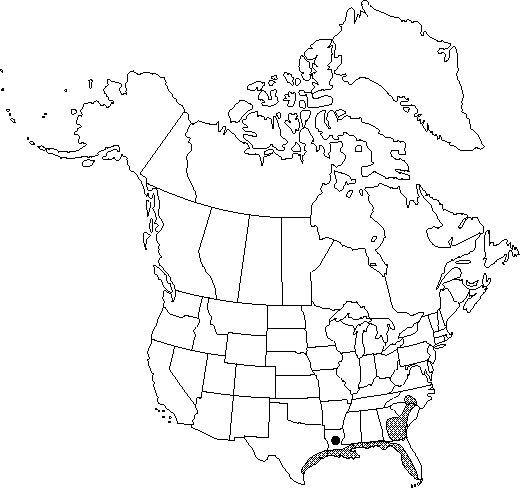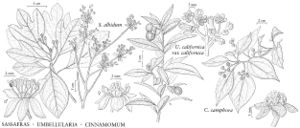Difference between revisions of "Cinnamomum camphora"
in F. Berchtold & J. S. Presl, Prir. Rostlin 2: 47. 1825.
FNA>Volume Importer |
FNA>Volume Importer |
||
| Line 30: | Line 30: | ||
}}<!-- | }}<!-- | ||
| − | --><span class="statement" id="st- | + | --><span class="statement" id="st-undefined" data-properties=""><b>Trees,</b> to 15 m. <b>Branches</b> terete, glabrous, terminal and axillary buds covered by imbricate bracts, young twigs with clusters of scars from fallen bracts. <b>Leaves</b> alternate; petiole to 3 cm. <b>Leaf</b> blade ovate to elliptic or elliptic-lanceolate, with (1-)3 primary veins, 7-12 × 3-5 cm, base rounded to cuneate, apex sharply acute; surfaces glabrous except for pubescent domatia in axils of main lateral veins. <b>Flowers</b>: tepals greenish white, 1-2 mm, glabrous abaxially, pubescent adaxially; stamens arranged in outer whorl of 6 (actually 2 whorls of 3) and inner whorl of 3. <b>Drupe</b> to 9 mm diam. <b>2n</b> = 24.</span><!-- |
-->{{Treatment/Body | -->{{Treatment/Body | ||
| Line 36: | Line 36: | ||
|habitat=Moist subtropical areas, including the Gulf Coast | |habitat=Moist subtropical areas, including the Gulf Coast | ||
|elevation=0-150 m | |elevation=0-150 m | ||
| − | |distribution=Ala.;Miss.;Fla.;Ga.;La.;N.C.;S.C.;Tex.;native;e Asia | + | |distribution=Ala.;Miss.;Fla.;Ga.;La.;N.C.;S.C.;Tex.;native;e Asia. |
|discussion=<p>Cinnamomum camphora is naturalized locally in the flora. Its crushed leaves have a strong smell of camphor. This species yields commercial camphor.</p><!-- | |discussion=<p>Cinnamomum camphora is naturalized locally in the flora. Its crushed leaves have a strong smell of camphor. This species yields commercial camphor.</p><!-- | ||
--><p>The name Cinnamomum camphora (Linnaeus) T. Nees & C. H. Ebermaier is nomenclaturally invalid.</p> | --><p>The name Cinnamomum camphora (Linnaeus) T. Nees & C. H. Ebermaier is nomenclaturally invalid.</p> | ||
| Line 57: | Line 57: | ||
|habitat=Moist subtropical areas, including the Gulf Coast | |habitat=Moist subtropical areas, including the Gulf Coast | ||
|elevation=0-150 m | |elevation=0-150 m | ||
| − | |distribution=Ala.;Miss.;Fla.;Ga.;La.;N.C.;S.C.;Tex.;native;e Asia | + | |distribution=Ala.;Miss.;Fla.;Ga.;La.;N.C.;S.C.;Tex.;native;e Asia. |
|introduced=true | |introduced=true | ||
|reference=None | |reference=None | ||
| Line 63: | Line 63: | ||
|publication year=1825 | |publication year=1825 | ||
|special status=Selected by author to be illustrated;Introduced | |special status=Selected by author to be illustrated;Introduced | ||
| − | |source xml=https://jpend@bitbucket.org/aafc-mbb/fna- | + | |source xml=https://jpend@bitbucket.org/aafc-mbb/fna-data-curation.git/src/9216fc802291cd3df363fd52122300479582ede7/coarse_grained_fna_xml/V3/V3_19.xml |
|genus=Cinnamomum | |genus=Cinnamomum | ||
|species=Cinnamomum camphora | |species=Cinnamomum camphora | ||
| − | |||
| − | |||
| − | |||
| − | |||
| − | |||
| − | |||
| − | |||
| − | |||
| − | |||
| − | |||
| − | |||
| − | |||
| − | |||
| − | |||
| − | |||
| − | |||
| − | |||
| − | |||
| − | |||
| − | |||
| − | |||
| − | |||
| − | |||
| − | |||
| − | |||
}}<!-- | }}<!-- | ||
-->[[Category:Treatment]][[Category:Cinnamomum]] | -->[[Category:Treatment]][[Category:Cinnamomum]] | ||
Revision as of 13:35, 27 July 2019
Trees, to 15 m. Branches terete, glabrous, terminal and axillary buds covered by imbricate bracts, young twigs with clusters of scars from fallen bracts. Leaves alternate; petiole to 3 cm. Leaf blade ovate to elliptic or elliptic-lanceolate, with (1-)3 primary veins, 7-12 × 3-5 cm, base rounded to cuneate, apex sharply acute; surfaces glabrous except for pubescent domatia in axils of main lateral veins. Flowers: tepals greenish white, 1-2 mm, glabrous abaxially, pubescent adaxially; stamens arranged in outer whorl of 6 (actually 2 whorls of 3) and inner whorl of 3. Drupe to 9 mm diam. 2n = 24.
Phenology: Flowering spring (Apr–May).
Habitat: Moist subtropical areas, including the Gulf Coast
Elevation: 0-150 m
Distribution

Ala., Miss., Fla., Ga., La., N.C., S.C., Tex., native, e Asia.
Discussion
Cinnamomum camphora is naturalized locally in the flora. Its crushed leaves have a strong smell of camphor. This species yields commercial camphor.
The name Cinnamomum camphora (Linnaeus) T. Nees & C. H. Ebermaier is nomenclaturally invalid.
Selected References
None.
